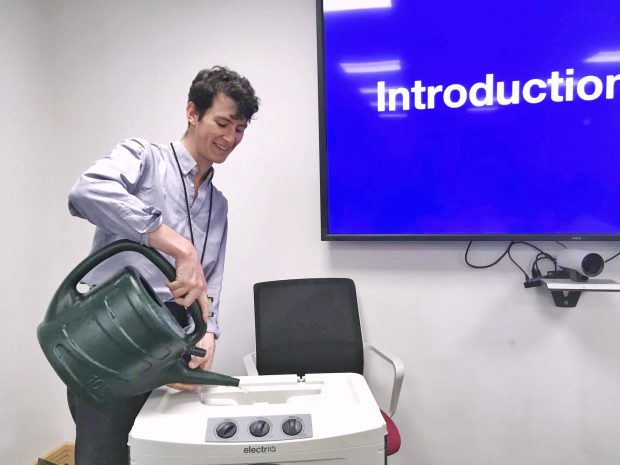
Over the past few months, the What Works Team and Policy Lab have been thinking a lot about innovation funds.
Innovation funds are grant funding programmes that give local groups and organisations financial backing to find innovative ways of tackling policy problems. The problems they are set up to solve range from the complex (like ‘how can we create better integrated communities?’) to the niche (‘what should Northern Ireland do with all its chicken poo?’). And they are becoming more popular: at any one time, about £1 billion is available through government innovation funds.
For Policy Lab and What Works, innovation funds provide an excellent way of tackling particularly thorny issues that departments are grappling with. But we’ve also come to realise that the way these funds are designed can really dictate how effective they are. So we’ve embarked on a project to understand what good design looks like and how these funds can be used to transform our knowledge of what works.
Last summer, in an inhumanely stuffy room in Westminster, we ran a workshop with about 25 civil servants involved in innovation funds. We wanted to understand what a successful fund looks like, the experience of the people who bid to funds, and how funds can be designed to maximise their impact. Here's what we’ve learned so far.

Are you asking the right question?
Setting the right research questions at the very start of the design process is really important.
Some funds start with a broad question, like the Govtech Catalyst fund, which is essentially asking “how can we make innovative use of emerging technologies to improve public service effectiveness?”. Others are focused on solving a very specific problem, like the Home Office’s Trusted Relationships Fund, which is asking which relationship-based local initiatives are most effective at preventing children from being exploited or abused.
Broad questions tend to be better at encouraging blue sky innovative thinking, and they’re great if you’re aiming to fuel the development of new technology or initiatives in a specific area.
On the other hand, more precise research questions are better for building the evidence base and generating real world impact. Funds that are more prescriptive about the outcomes they are interested in allow you to compare different interventions against each other and understand which approaches are most effective in solving the problem you are interested in.
How to create a legacy
The type of research question you use will depend on your intended impact, so it’s worth thinking early on about the fund’s legacy.
If you’re looking to kick-start an industry – take the Faraday Challenge fund for example, which intends to grow the automotive battery industry – then you can use an innovation fund to direct seed funding to pioneers in the area so that they can develop and bring new products to the market.
But what if you’re not confident that there is a market that’ll sustain the success of the best innovations? If the market is weak, it’s likely that once the funding runs out, the innovation will struggle to grow or sustain itself. This is where generating evidence comes in.
Building the evidence base around the programmes and products enabled by innovation funds opens up options for long-term impact. Impact evidence – like the kind generated in randomised controlled trials – provides robust assurance of which programmes are truly working and which are not. With this information the most impactful charities or businesses receiving funding can make a stronger, stand-out case for funding to investors. If that sounds familiar, it might be because it’s the basis of the effective altruism movement.
At a time when budgets are tight, this evidence also helps local authorities and central government understand whether follow up funding makes sense.

Tiered-evidence funds – like the US i3 Fund – make great use of impact evaluations both to enable bold innovation and to scale up approaches that improve desired outcomes. Small-scale pilots funded and evaluated in the bottom ‘development’ tier of these funds tend to be promising but untested. But if they demonstrate impact they can be retested and expanded through ‘validation’ and then ‘scale-up’ grants.
This type of fund reduces risk and enables more confident and generous investment in effective innovations.
Genuinely competitive bids
We need to be careful about how we use public money, and there are a number of checks and balances in place throughout government procurement processes to make sure that cash is not misspent.
That said, there is a risk that innovation funds favour bidders that have the resources to research funds and write bids. This limits the number and range of ideas pitched to the fund and consequently reduces its odds of having a big impact.
The best funds we've encountered make use of market-warming exercises to raise awareness and encourage applications from a wide range of bidders. Some funds, like the Trusted Relationship Fund, ask bidders for short ‘expressions of interest’ so that they can identify and help smaller organisations complete the more complex full application later on.
Policy Lab has recent first hand experience here: we worked with the Department for Culture, Media and Sport to host a number of ‘readiness events’ for potential bidders to the Innovation in Democracy Programme. We wrote a blog about this here and made all the resources available here.
Help is at hand
Designing an innovation fund can be a daunting task. The What Works Team and Policy Lab already offer a number of tools and resources to help with the process including free expert advice on programme evaluation.
We used some of them on that hot day last summer and will carry on applying our joint Policy Lab and What Works approach – iterative, evidence-based and open – as we continue this project. Stay tuned!
If you’d like to be informed of new blog posts, including articles on innovation funding, you can subscribe to our blogs:
Or follow us on twitter @WhatWorksUK and @PolicyLabUK
Leave a comment